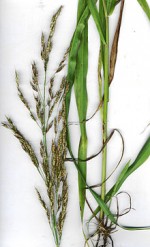 Considered one of the ten worst weeds in the world, Johnson grass is a perennial weed native to the Mediterranean region but growing throughout Europe, as well as in the Middle East and Asia. It was introduced into the United States in the early 1800s as a forage crop and named after an Alabama plantation owner who planted it in a river bottom a few decades later. It is now found in almost every state including Hawaii and considered a noxious weed in many. Johnson grass prefers full sun and dry to moist fertile soil but tolerates partial sun and many kinds of soil. It is especially prevalent in disturbed soil such as abandoned and cultivated fields, pastures, forest edges, gardens, roadsides, and along streambanks and aggressively spreads into new areas by rhizomes and seed, forming dense colonies. Although the plant is edible it may cause bloat in livestock due to a high concentration of nitrates.
Considered one of the ten worst weeds in the world, Johnson grass is a perennial weed native to the Mediterranean region but growing throughout Europe, as well as in the Middle East and Asia. It was introduced into the United States in the early 1800s as a forage crop and named after an Alabama plantation owner who planted it in a river bottom a few decades later. It is now found in almost every state including Hawaii and considered a noxious weed in many. Johnson grass prefers full sun and dry to moist fertile soil but tolerates partial sun and many kinds of soil. It is especially prevalent in disturbed soil such as abandoned and cultivated fields, pastures, forest edges, gardens, roadsides, and along streambanks and aggressively spreads into new areas by rhizomes and seed, forming dense colonies. Although the plant is edible it may cause bloat in livestock due to a high concentration of nitrates.
 Description: Johnson grass sprouts in early spring from underground rhizomes sending up erect stems that are pink to rusty red near the base and 2-8 feet tall. The green to dark green leafs are up to 2 feet long and 1 inch across and usually have a prominent white central vein, thus resembling corn leaves although smaller. When the plants are about 2-4’ tall the stems produce large loose panicles of florets up to l½ foot long. Each panicle is composed of many small opposite branches bearing flowers and their purplish sheaths. The reddish brown seeds that follow are oval and almost 1/8 inch long. The root system is fibrous with pink scaly rhizomes. After blooming the plant dies back to its roots.
Description: Johnson grass sprouts in early spring from underground rhizomes sending up erect stems that are pink to rusty red near the base and 2-8 feet tall. The green to dark green leafs are up to 2 feet long and 1 inch across and usually have a prominent white central vein, thus resembling corn leaves although smaller. When the plants are about 2-4’ tall the stems produce large loose panicles of florets up to l½ foot long. Each panicle is composed of many small opposite branches bearing flowers and their purplish sheaths. The reddish brown seeds that follow are oval and almost 1/8 inch long. The root system is fibrous with pink scaly rhizomes. After blooming the plant dies back to its roots.

 Control: Because Johnson grass has a prolific seed production and extensive rhizome system that sprouts when fragmented it is difficult to control. Plants should be dug out as soon as they are identified with care taken to get the soil around the root system so as not to break off fragments that will sprout. This is virtually impossible and inevitably new plants will replace the old that will have to be dug out. Small root fragments may be killed by freezing temperatures so tilling in the fall to bring them closer to the surface is helpful. Winning the battle against Johnson weed by digging and tilling is a long arduous process but can be done by the conscientious gardener. Mowing heavy infestations of Johnson grass weakens the plant as well as reduces seed production and should be done regularly if only to prevent the spread of the weed into garden beds. Post-emergent herbicides such as glyphosate is useful but treatment may need to be repeated for several years.
Control: Because Johnson grass has a prolific seed production and extensive rhizome system that sprouts when fragmented it is difficult to control. Plants should be dug out as soon as they are identified with care taken to get the soil around the root system so as not to break off fragments that will sprout. This is virtually impossible and inevitably new plants will replace the old that will have to be dug out. Small root fragments may be killed by freezing temperatures so tilling in the fall to bring them closer to the surface is helpful. Winning the battle against Johnson weed by digging and tilling is a long arduous process but can be done by the conscientious gardener. Mowing heavy infestations of Johnson grass weakens the plant as well as reduces seed production and should be done regularly if only to prevent the spread of the weed into garden beds. Post-emergent herbicides such as glyphosate is useful but treatment may need to be repeated for several years.
Photo Credit: Wikipedia